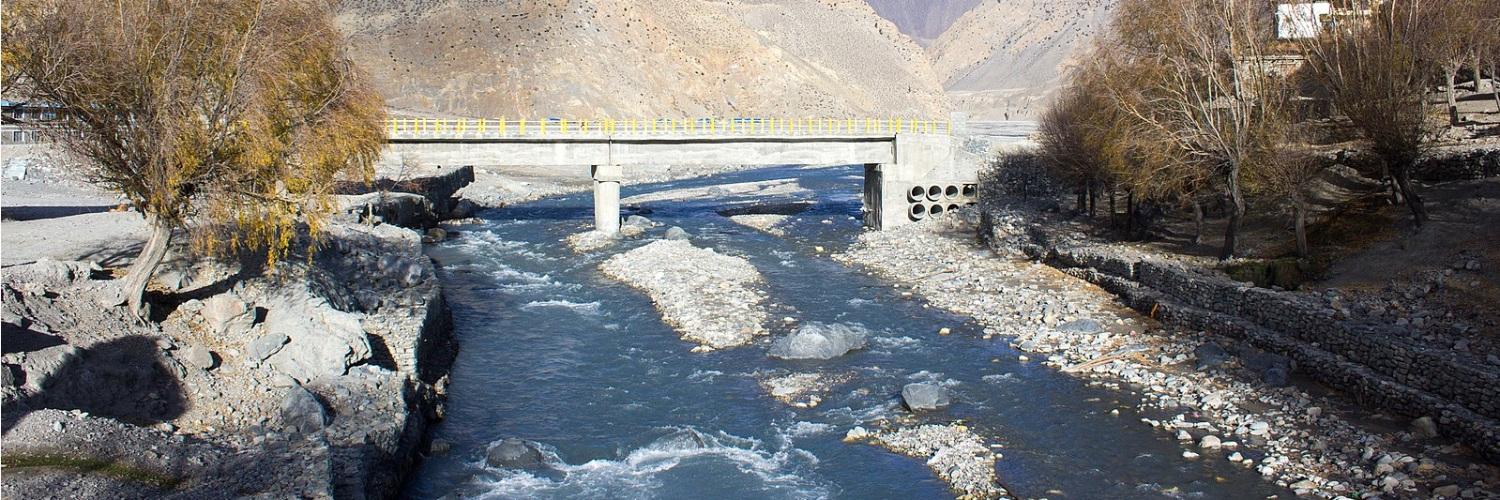In the spiritual heart of Nepal, amidst the windswept valleys and sacred waters of the Himalayas, flows the Kaligandaki River - a river unlike any other. This holy watercourse is not just a natural wonder, but a divine source of one of the most revered objects in Hindu tradition: the Shaligram stone.
Known for its mysterious markings, fossilized spiral shapes, and unshakable sacredness, the Shaligram holds a powerful position in Vedic culture and spiritual life. Believed to be a manifestation of Lord Vishnu himself, Shaligrams are not man-made idols but naturally formed ammonite fossils found only in the Kaligandaki River valley of Nepal - making their existence and origin both spiritually profound and geographically unique.
Worshipped by devotees across Nepal and India, the Shaligram is more than a symbol - it is a living presence of divinity, devotion, and cosmic energy. For spiritual seekers and religious travelers, a journey to the source of these sacred stones is not merely a trek; it's a pilgrimage of soul-stirring significance.
In this detailed guide, we’ll explore the meaning, origin, types, significance, spiritual practices, and the cultural mystery surrounding Shaligram stones, along with practical travel tips for those who wish to embark on a sacred journey to the Kaligandaki River.
What is a Shaligram? (Origin, Science & Myth)
The Shaligram, often called Shaligram stone, is one of the most sacred and mysterious objects of worship in Hinduism. At first glance, it appears to be a black or dark brown fossilized stone - oval or spherical, with natural chakra markings or spiral imprints. But within Hindu and Vaishnavite belief, it is far more than just a relic of ancient times. The Shaligram is revered as the non-anthropomorphic representation of Lord Vishnu, the preserver of the universe.
Mythological Origins
According to ancient Hindu scriptures and Puranas, the Shaligram originated from a divine event involving Lord Vishnu and the demon king Jalandhara. When Vishnu tricked Jalandhara's virtuous wife, Vrinda, to break her chastity, he was cursed to turn into a stone. As a result, he assumed the form of Shalagram Shila to reside in the sacred Kaligandaki River. Vrinda herself was reborn as the Tulsi plant, which is why the Shaligram is never worshipped without a Tulsi leaf.
This deep mythological context is what makes the Shaligram not just a religious icon, but also a powerful symbol of penance, preservation, and cosmic balance.
Scientific Explanation
From a geological standpoint, Shaligrams are fossilized ammonites - marine cephalopods that existed around 100-300 million years ago during the Jurassic period. These spiral-shaped fossils are found exclusively in the Kaligandaki River valley, nestled between the Annapurna and Dhaulagiri Himalayan ranges. Their presence here is due to the region’s ancient history as part of the Tethys Sea before the rise of the Himalayas.
This rare natural formation, combined with their sacred mythology, elevates Shaligrams to a unique position: scientifically fascinating, spiritually irreplaceable.
Spiritual Significance
For devotees, possessing or even seeing a Shaligram is a deeply spiritual experience. Unlike temple idols that require consecration through rituals (pran pratishtha), the Shaligram is considered swayambhu - self-manifested and eternally pure. It requires no elaborate puja or installation; its divine presence is inherent.
People keep it in homes, temples, or pilgrimage shrines for blessings of:
-
Peace and prosperity
-
Spiritual protection
-
Liberation (Moksha)
-
Divine presence of Lord Vishnu
Where is the Shaligram Found? (The Sacred Kaligandaki River)
The Kaligandaki River, also known as Kali Gandaki, is not only one of Nepal’s holiest rivers but also the only known natural source of Shaligram stones in the world. Flowing through the remote highlands of the Mustang region, this sacred river carves its way between two of the tallest mountain ranges - the Annapurna and the Dhaulagiri - forming what is known as the world’s deepest gorge.
But more than its geographical extremes, the Kaligandaki is revered for something far greater: its spiritual gifts.
A River of Divinity
Named after the fierce goddess Kali, the Kaligandaki River is believed to embody both the divine feminine energy (Shakti) and preserving energy (Vishnu) - a rare duality in Hindu symbolism. The river’s dark silt and fossil-rich deposits are seen as manifestations of cosmic creation. It is here, amidst the cold Himalayan waters, that Shaligram stones lie quietly embedded in the riverbed or washed onto the banks during monsoon flow.
Unlike other religious icons crafted by human hands, Shaligrams found in Kaligandaki are purely formed by nature and time - making them untouched, uncarved, and divinely sanctioned.
The Journey to Find Shaligram
Many spiritual travelers, pilgrims, and religious seekers visit this region with one aim - to witness or collect an authentic Shaligram. However, the journey is not just physical; it’s deeply transformational. Walking along the river, chanting Vishnu’s name, and meditating with the sound of the flowing Kaligandaki is considered a tapasya (spiritual discipline) in itself.
Most stones are collected respectfully during early morning walks, especially after the rainy season when water levels retreat, revealing untouched stones embedded in the sand and rock.
Types of Shaligram Stones and Their Meanings
Not all Shaligram stones are the same. Each stone carries unique natural markings, shapes, and chakra imprints that correspond to different forms and aspects of Lord Vishnu. These variations hold specific spiritual meanings, blessings, and rituals, making the Shaligram collection deeply symbolic and personalized for worshippers.
Classification of Shaligram by Markings and Shapes
The markings on Shaligrams are naturally formed and never artificially created. Devotees identify these stones based on the chakras (wheel-like symbols), lines, and dots visible on their surfaces. Each pattern is said to represent a particular avatar (incarnation) or form of Lord Vishnu, such as:
-
Shankha (Conch) shape: Symbolizes the divine sound of creation.
-
Chakra (Discus) markings: Represent the Sudarshana Chakra, a powerful weapon of Vishnu.
-
Lotus petals and floral patterns: Indicate purity and spiritual enlightenment.
-
Peacock feather-like patterns: Associated with Krishna, one of Vishnu’s most beloved avatars.
-
Spiral and circular grooves: Symbolize the eternal cosmic cycle.
Popular Types of Shaligram and Their Divine Forms
Here are some commonly recognized Shaligram types and their spiritual significance:
|
Shaligram Type |
Divine Form Represented |
Significance & Blessings |
|---|---|---|
|
Kaustubha |
Lord Vishnu himself |
Grants wealth, protection, and spiritual awakening |
|
Gandaki |
Sudarshana Chakra |
Protection from evil, strength, and courage |
|
Lakshmi Narayan |
Vishnu with Goddess Lakshmi |
Prosperity, marital harmony, and abundance |
|
Narasimha |
The Lion-Man avatar |
Protection against enemies and fearlessness |
|
Varaha |
The Boar avatar |
Earth’s restoration, health, and grounding |
|
Vamana |
The Dwarf avatar |
Humility, wisdom, and spiritual growth |
How to Identify Authentic Shaligrams
Authentic Shaligrams are only found in the Kaligandaki River and bear distinct natural fossil markings that cannot be replicated. Here are a few tips for identification:
-
The stone must be lightweight yet solid.
-
It should have distinct natural chakra marks or spiral fossil patterns.
-
It will have no artificial carving or polishing - any such modification means it is not an authentic Shaligram.
-
The surface is usually dark grey, black, or brown with natural fossil textures.
-
Devotees traditionally do not touch Shaligrams directly with bare hands, instead using a cloth or leaves during worship.
Spiritual Practices Linked to Types of Shaligram
Different Shaligram types may be worshipped with specific mantras, offerings, and rituals. For example:
-
The Narasimha Shaligram is especially worshipped to ward off evil spirits and provide protection.
-
The Lakshmi Narayan Shaligram is believed to bring wealth and harmonious family life.
-
Worshipping the Varaha Shaligram is said to enhance physical health and vitality.
These diverse meanings allow spiritual travelers to select or revere Shaligrams that resonate personally with their spiritual goals.
Spiritual Importance & Rituals of Shaligram Worship
The Shaligram stone holds a unique place in Hindu worship as a direct and self-manifested representation of Lord Vishnu. For spiritual travelers and devotees, understanding the rituals and reverence surrounding the Shaligram is essential to experiencing its full divine power.
Why Worship Shaligram?
The Shaligram is more than just a holy stone - it is a living embodiment of Vishnu’s energy, making it an ever-present source of divine blessings and protection. Devotees believe that worshipping the Shaligram:
-
Invokes Vishnu’s presence in the home or temple.
-
Brings spiritual upliftment and peace.
-
Protects from negative energies and obstacles.
-
Grants prosperity, health, and longevity.
-
Acts as a medium for meditation and connection with the cosmic consciousness.
Many spiritual travelers carry small Shaligram stones as portable sanctuaries of Vishnu’s power during their journeys or place larger ones in household shrines.
How to worship Shaligram? (Common Rituals and Practices)
Worshipping the Shaligram involves a few distinct practices:
-
Bathing the stone: It is customary to bathe the Shaligram with holy water (preferably from the Kaligandaki River, Ganges, or Tulsi water).
-
Offering Tulsi leaves: The Tulsi plant is sacred to Vishnu, and no Shaligram worship is complete without offering fresh Tulsi leaves.
-
Chanting Vishnu mantras: Popular chants include the Vishnu Sahasranama and simple mantras like “Om Namo Bhagavate Vasudevaya”.
-
Lighting incense and lamps: These purify the atmosphere and symbolize the light of divine knowledge.
-
Offering flowers and fruits: As symbols of devotion and gratitude.
Special Worship Days
Certain days hold special significance for Shaligram worship:
-
Ekadashi (the 11th lunar day) is considered highly auspicious for Vishnu worship.
-
Janmashtami, the birthday of Lord Krishna (an avatar of Vishnu), sees elaborate Shaligram pujas.
-
Tulsi Vivah (marriage of Tulsi plant to Vishnu) is another important occasion.
Do’s and Don’ts in Shaligram Worship
To maintain the sanctity of the Shaligram, devotees observe these guidelines:
-
Avoid touching the Shaligram directly with bare hands.
-
Do not place the stone on the floor or any unclean surface.
-
Keep the Shaligram in a clean, sacred space, ideally in a dedicated altar.
-
Perform daily or regular puja to keep the divine energy active.
-
Never place other idols or objects on top of the Shaligram.
The reverence given to the Shaligram reveals the depth of devotion and the intimate relationship devotees have with Lord Vishnu’s living presence.
Conclusion: Shaligram and the Pilgrimage
The Shaligram stone is much more than a sacred fossil - it is a living symbol of Lord Vishnu’s divine presence, bridging the earthly and the cosmic. For spiritual travelers and devotees, holding or worshipping a Shaligram stone is an experience that brings blessings, protection, and a profound connection to Hindu spirituality.
Pilgrimage to the Kaligandaki River - the exclusive natural source of these sacred stones - offers an unforgettable journey into Nepal’s spiritual heartland. Along with the breathtaking Himalayan landscapes and the vibrant cultures of Mustang and Kagbeni, the pilgrimage invites inner transformation, devotion, and renewal.
Whether you are a seasoned pilgrim or embarking on your first spiritual journey, the Shaligram pilgrimage presents an opportunity to deepen your faith, explore ancient traditions, and experience the sacred in a tangible way.
If you are ready to take this journey or wish to learn more about the Shaligram stone and the spiritual sites of Nepal, Best Heritage Tour is here to guide and support you with expert planning, trusted local knowledge, and heartfelt hospitality.
Contact Information’s:
Phone: +977-9851149197
Email: info@bestheritagetour.com
Website: www.bestheritagetour.com
Office Location: Thamel Marg, Kathmandu Nepal
Begin your sacred pilgrimage today - contact Best Heritage Tour and step into a timeless world of devotion and divine grace.
Author: Best Heritage Tour
Date: 20th June, 2025




